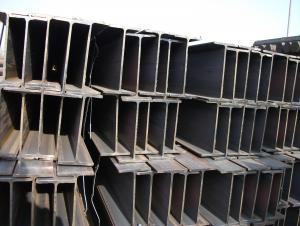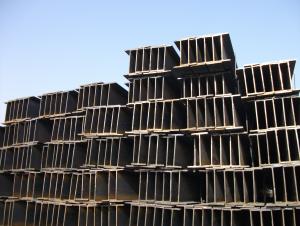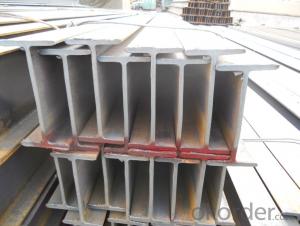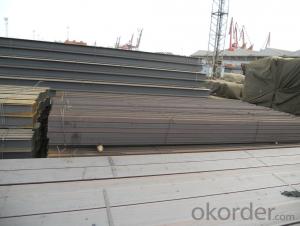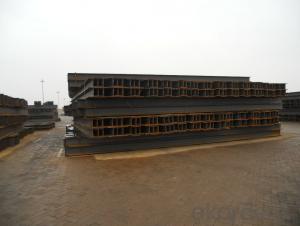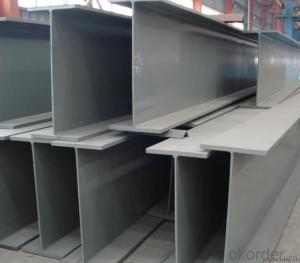H beams
- Loading Port:
- China Main Port
- Payment Terms:
- TT OR LC
- Min Order Qty:
- -
- Supply Capability:
- -
OKorder Service Pledge
OKorder Financial Service
You Might Also Like
Structural Steel H Beam Details:
| Minimum Order Quantity: | 100MT | Unit: | m.t. | Loading Port: | China Main Port |
| Supply Ability: | 10000MT | Payment Terms: | TT or LC |
Product Description:
Specifications of Hot Rolled Structural Steel H Beam
1. Standard: GB700-88, Q235B2.
2. Grade: Q235, SS400 or Equivalent
3. Length: 6m,10m, 12m as following table
4. Invoicing on theoretical weight or actual weight as customer request
5.Payment: TT or L/C
6. Sizes:
SIZE(mm) | DIMENSION(kg/m) |
100*100 | 16.9 |
125*125 | 23.6 |
150*75 | 14 |
150*150 | 31.1 |
148*100 | 20.7 |
198*99 | 17.8 |
200*100 | 20.9 |
248*124 | 25.1 |
250*125 | 29 |
Usage & Applications of Hot Rolled Structural Steel H Beam
Commercial building structure ;Pre-engineered buildings; Machinery support structure; Prefabricated structure; Medium scale bridges; Ship-building structure. etc.
Packaging & Delivery of Hot Rolled Structural Steel H Beam
1. Packing: it is nude packed in bundles by steel wire rod
2. Bundle weight: not more than 3.5MT for bulk vessel; less than 3 MT for container load
3. Marks:
Color marking: There will be color marking on both end of the bundle for the cargo delivered by bulk vessel. That makes it easily to distinguish at the destination port.
Tag mark: there will be tag mark tied up on the bundles. The information usually including supplier logo and name, product name, made in China, shipping marks and other information request by the customer.
If loading by container the marking is not needed, but we will prepare it as customer request.
4. Transportation: the goods are delivered by truck from mill to loading port, the maximum quantity can be loaded is around 40MTs by each truck. If the order quantity cannot reach the full truck loaded, the transportation cost per ton will be little higher than full load.
5. Delivered by container or bulk vessel
Production flow of Hot Rolled Structural Steel H Beam
Material prepare (billet) —heat up—rough rolling—precision rolling—cooling—packing—storage and transportation
- Q:How do steel H-beams perform in extreme weather conditions such as hurricanes or cyclones?
- Steel H-beams are renowned for their exceptional strength and durability, which has made them a popular option for various construction applications, including in areas susceptible to severe weather conditions like hurricanes or cyclones. Steel H-beams have proven to be highly dependable when it comes to withstanding the forces exerted by these weather events. The distinctive structural design of H-beams, featuring flanges and a web, allows for the even distribution of loads along their length, making them resistant to bending or buckling. This structural integrity enables H-beams to endure the powerful winds and forces generated by hurricanes or cyclones. During extreme weather conditions like hurricanes, wind speeds can reach incredibly high velocities. The aerodynamic design of H-beams, characterized by their streamlined shape and minimal surface area, helps reduce wind resistance. This significantly reduces the likelihood of the beams being blown away or damaged during the storm. Furthermore, steel H-beams possess excellent corrosion resistance properties. They are often galvanized or coated with protective coatings, which prevent rust or deterioration caused by moisture, a common occurrence during hurricanes or cyclones. This ensures that the structural integrity of the beams remains intact even after prolonged exposure to extreme weather conditions. In addition, steel H-beams have a high load-bearing capacity, allowing them to support heavy loads such as roofs, walls, or floors. This strength is particularly vital during hurricanes or cyclones, where the beams must withstand not only the wind forces but also the weight of debris or falling objects. In conclusion, steel H-beams are engineered to perform exceptionally well in extreme weather conditions such as hurricanes or cyclones. Their strength, durability, resistance to bending and buckling, corrosion resistance, and high load-bearing capacity make them a reliable choice for construction in areas prone to such weather events.
- Q:What are the different types of steel H-beam profiles available?
- There are several different types of steel H-beam profiles available, including standard H-beams, wide flange beams, and I-beams. Each profile has its own unique dimensions and characteristics, allowing for various applications in the construction and engineering industries.
- Q:How do steel H-beams perform in heavy snow loads?
- Due to their exceptional strength and load-bearing capacity, steel H-beams are widely utilized in the construction industry. They excel particularly well in handling heavy snow loads. The H-beam design allows for the even distribution of weight along its length, making it ideal for withstanding the accumulation of snow. The unique shape of the H-beam provides a high moment of inertia, which helps minimize deflection and ensures structural stability in the face of heavy snow loads. Moreover, the high tensile strength of steel H-beams enables them to resist bending and deformation caused by the weight of the snow. This strength guarantees that the beams can endure the pressure exerted by the snow without compromising the integrity of the building or infrastructure. In addition, steel H-beams exhibit remarkable durability and resistance to corrosion, making them suitable for long-term use in areas prone to heavy snowfall. The steel's ability to withstand harsh weather conditions, including extreme cold and moisture, guarantees that the H-beams retain their structural properties even in snowy environments. In summary, steel H-beams are an excellent choice for handling heavy snow loads. Their strength, load-bearing capacity, and durability make them a reliable option for supporting structures under the weight of snow. They provide stability and safety in areas that experience heavy snowfall.
- Q:What are the different grades of steel used for H-beams?
- The different grades of steel commonly used for H-beams include A36, A572, and A992.
- Q:Can steel H-beams be used in the construction of power plants?
- Certainly! Steel H-beams are indeed suitable for power plant construction. These beams are widely utilized in the field of construction due to their strength, durability, and versatility. They offer structural support and stability, making them appropriate for a variety of applications within power plants. In the construction of power plant buildings, steel H-beams can be employed to support heavy machinery and equipment, as well as serve as the structural framework for the plant's infrastructure. Moreover, steel H-beams possess a remarkable load-bearing capacity and can withstand high temperatures, making them highly suitable for power plant environments. Consequently, steel H-beams are a dependable and frequently employed material in the construction of power plants.
- Q:How do steel H-beams contribute to the overall sustainability of a structure?
- Steel H-beams contribute to the overall sustainability of a structure in several ways. Firstly, steel is a highly durable material that can withstand extreme weather conditions, seismic activities, and fire, which ensures the longevity and safety of the structure. This durability reduces the need for frequent repairs or replacements, minimizing the consumption of resources and waste generation. Additionally, steel H-beams are lightweight compared to other building materials like concrete or wood, which reduces the overall weight of the structure. This lightweight characteristic allows for more efficient transportation and construction processes, leading to reduced energy consumption and carbon emissions during construction. Moreover, steel H-beams are highly recyclable, making them a sustainable choice. At the end of a building's life cycle, these beams can be easily dismantled and recycled into new steel products without losing their inherent properties. Recycling steel reduces the demand for virgin materials, conserves energy, and reduces greenhouse gas emissions associated with the production of new steel. Furthermore, steel H-beams offer design flexibility, allowing architects and engineers to create innovative and efficient structures. Their versatility enables the optimization of material usage, reducing waste and maximizing the use of resources. This adaptability also facilitates the future adaptability of the structure, allowing for modifications or expansions without extensive demolition or reconstruction. Lastly, steel H-beams have a high strength-to-weight ratio, meaning they can support larger loads with less material. This efficiency in material usage reduces the overall environmental impact of the structure, as less steel is required to achieve the same structural integrity. Therefore, the use of steel H-beams in construction contributes to the conservation of resources and minimizes the carbon footprint of the building. In conclusion, steel H-beams contribute to the overall sustainability of a structure through their durability, lightweight nature, recyclability, design flexibility, and efficient material usage. By choosing steel H-beams, we can create structures that are not only safe and long-lasting but also environmentally friendly, conserving resources and reducing the carbon footprint of the construction industry.
- Q:What are the different surface coatings available for steel H-beams?
- Various surface coatings are available for steel H-beams, each offering unique benefits and protection. These coatings encompass the following options: 1. Paint: The most common and cost-effective coating for steel H-beams is paint. It creates a protective layer that prevents corrosion and can be customized with different colors or finishes. Periodic maintenance and touch-ups are necessary to maintain its effectiveness. 2. Galvanizing: A prevalent coating for steel H-beams is galvanizing, which involves applying a layer of zinc through hot-dip galvanization. This coating provides excellent corrosion resistance and is particularly suitable for outdoor applications or environments with high humidity or exposure to chemicals. 3. Powder Coating: Powder coating is an environmentally friendly and durable option for steel H-beams. It entails applying a dry powder that is then heated and fused into a smooth and protective layer. Powder coatings resist corrosion, chemicals, and UV rays, making them suitable for indoor and outdoor use. 4. Epoxy Coating: Epoxy coatings are commonly used in industrial or marine settings where superior chemical resistance is required. These coatings are applied in multiple layers and offer excellent protection against corrosion, abrasion, and impact. 5. Chrome Plating: Chrome plating involves depositing a thin layer of chromium onto the surface of steel H-beams. This coating provides exceptional corrosion resistance and a reflective, visually appealing finish. It is often used for decorative or high-end applications. 6. Thermal Spray Coatings: Thermal spray coatings encompass applying a molten material onto the steel H-beam surface using a specialized spraying process. The materials used can include zinc, aluminum, or ceramics, depending on the desired properties. Thermal spray coatings offer excellent corrosion resistance, thermal insulation, or wear resistance, depending on the material applied. When selecting a surface coating for steel H-beams, it is important to consider the specific application and environmental conditions. Consulting with a coatings specialist or manufacturer can help determine the most appropriate coating based on performance requirements, aesthetics, and budget.
- Q:How do steel H-beams contribute to architectural design?
- Architectural design relies heavily on steel H-beams due to the multitude of advantages they offer. Foremost, H-beams are renowned for their strength and durability. They possess a high load-bearing capacity, allowing architects to design buildings with larger open spaces and longer spans, eliminating the need for additional supporting columns or walls. This grants architects the freedom to create flexible and versatile spaces, particularly advantageous in commercial and industrial settings where expansive areas are often required. Furthermore, steel H-beams exhibit exceptional resistance against various forces such as wind, earthquakes, and vibrations. Their sturdy nature enables them to evenly absorb and distribute these forces throughout the structure, ensuring the building's safety and stability. This becomes especially crucial in areas prone to natural disasters or regions with high wind speeds. Apart from their structural benefits, H-beams also contribute significantly to the aesthetic appeal of architectural designs. Their sleek and minimalist design allows for clean lines and a modern look, making them a popular choice among architects and designers. Moreover, the versatility of H-beams permits creative and innovative designs, enabling architects to craft unique and visually striking structures. Additionally, steel H-beams come in various sizes and shapes, affording architects the flexibility to design structures of different scales and complexities. This versatility facilitates the realization of a wide range of architectural styles, from towering skyscrapers to cozy residential buildings. Moreover, H-beams boast high sustainability and environmental friendliness. Steel is a recyclable material, and incorporating H-beams in construction helps reduce the demand for new steel production, thereby minimizing the building's carbon footprint. Additionally, steel structures are known for their long lifespan, requiring minimal maintenance and reducing the need for future renovations or demolitions. In conclusion, steel H-beams play a crucial role in architectural design, providing strength, durability, and aesthetic appeal. Their ability to support large open spaces, withstand external forces, and adapt to various design styles makes them an indispensable and versatile component in the construction industry.
- Q:Are steel H-beams suitable for long-span structures?
- Yes, steel H-beams are suitable for long-span structures. They are known for their high strength-to-weight ratio, which allows them to support heavy loads over large distances without excessive deflection. Their structural integrity and versatility make them a popular choice for various long-span applications such as bridges, industrial buildings, and large roof structures.
- Q:What are the typical fabrication tolerances for steel H-beams?
- The typical fabrication tolerances for steel H-beams can vary depending on the specific manufacturer and the intended application. However, generally speaking, the typical fabrication tolerances for steel H-beams range from +/- 1/8 inch to +/- 1/4 inch in terms of dimensional accuracy. This means that the actual dimensions of the H-beams can deviate within these tolerances from the specified dimensions.
1. Manufacturer Overview |
|
|---|---|
| Location | |
| Year Established | |
| Annual Output Value | |
| Main Markets | |
| Company Certifications | |
2. Manufacturer Certificates |
|
|---|---|
| a) Certification Name | |
| Range | |
| Reference | |
| Validity Period | |
3. Manufacturer Capability |
|
|---|---|
| a)Trade Capacity | |
| Nearest Port | |
| Export Percentage | |
| No.of Employees in Trade Department | |
| Language Spoken: | |
| b)Factory Information | |
| Factory Size: | |
| No. of Production Lines | |
| Contract Manufacturing | |
| Product Price Range | |
Send your message to us
H beams
- Loading Port:
- China Main Port
- Payment Terms:
- TT OR LC
- Min Order Qty:
- -
- Supply Capability:
- -
OKorder Service Pledge
OKorder Financial Service
Similar products
New products
Hot products
Related keywords
